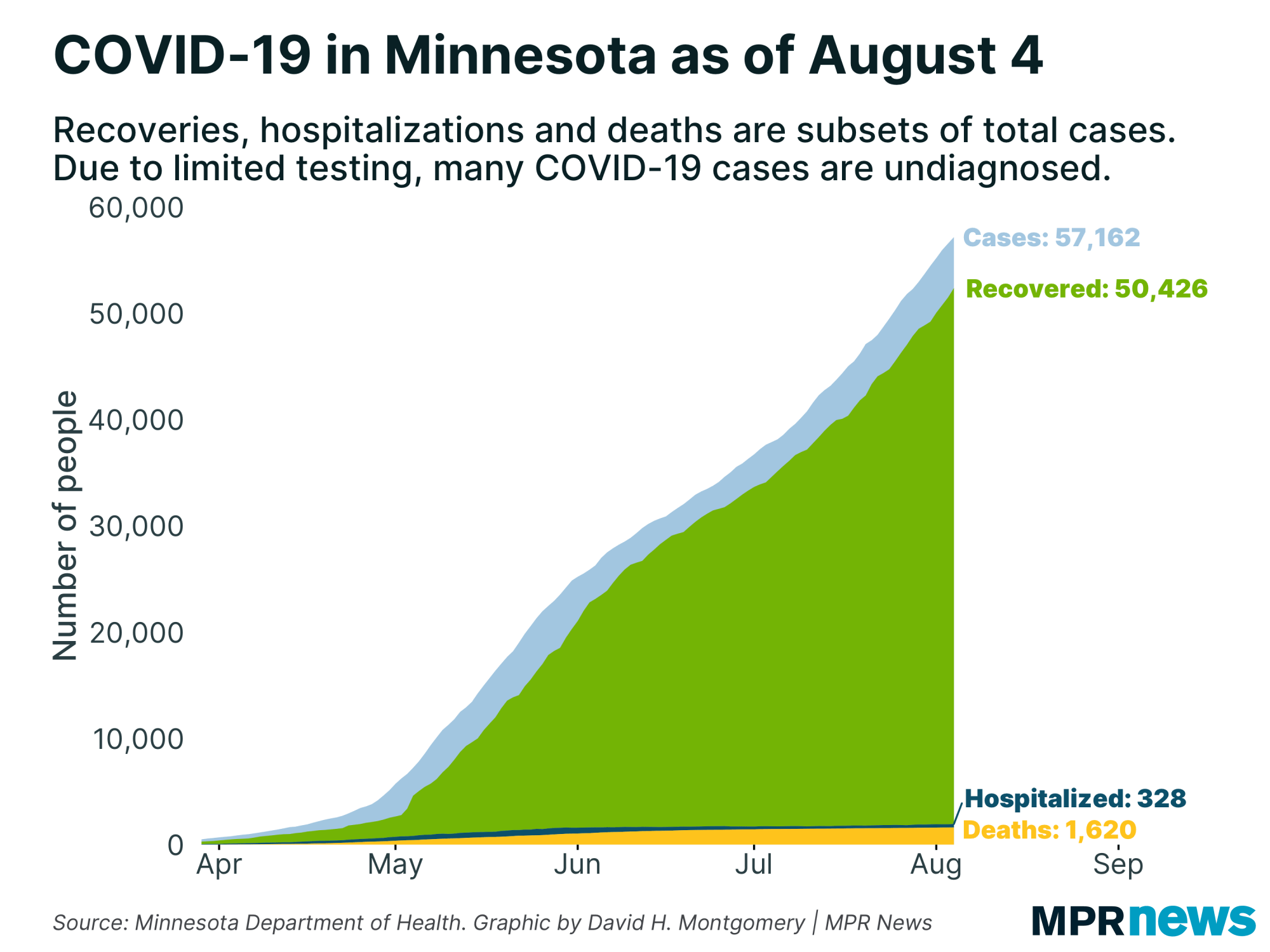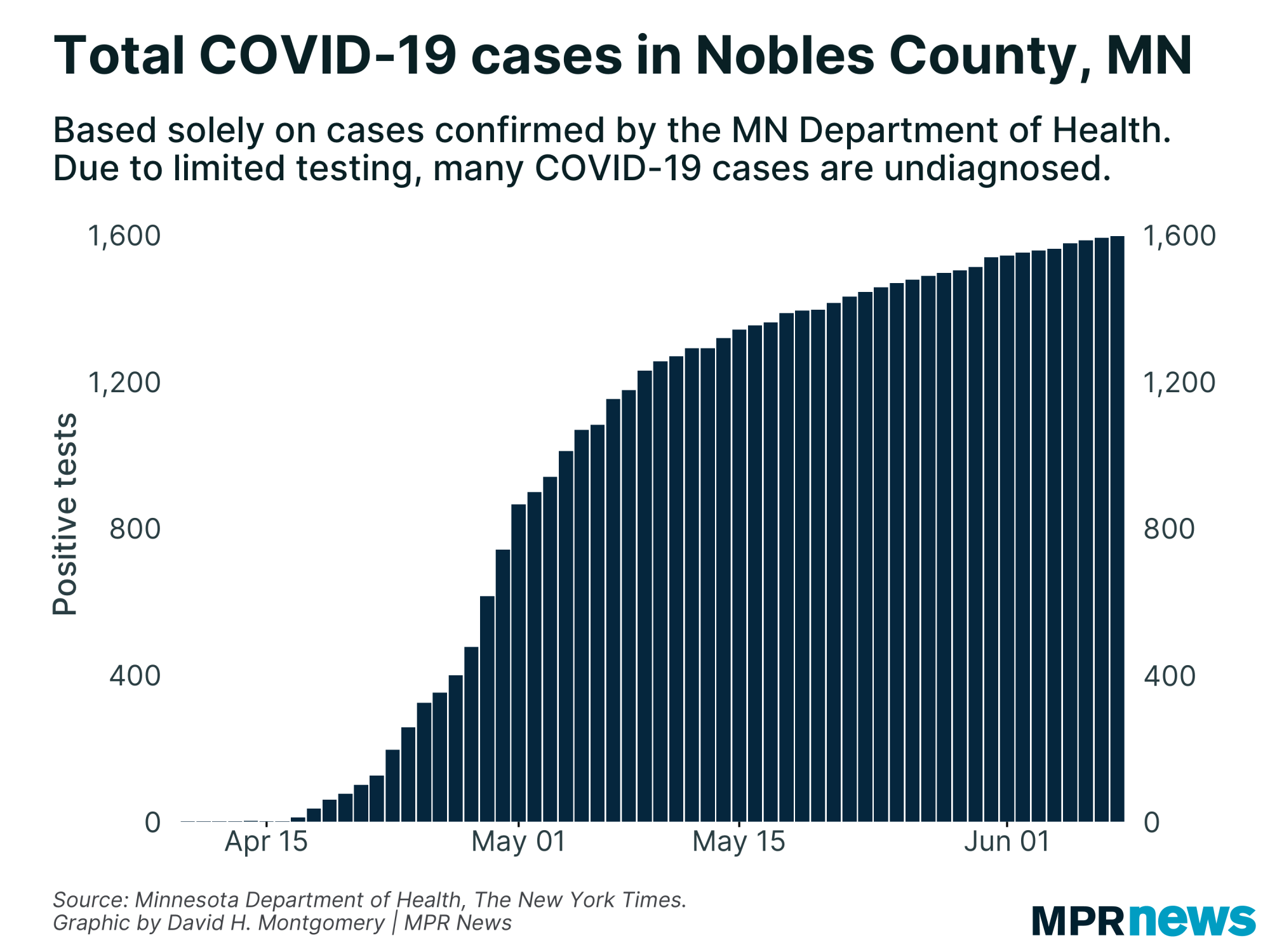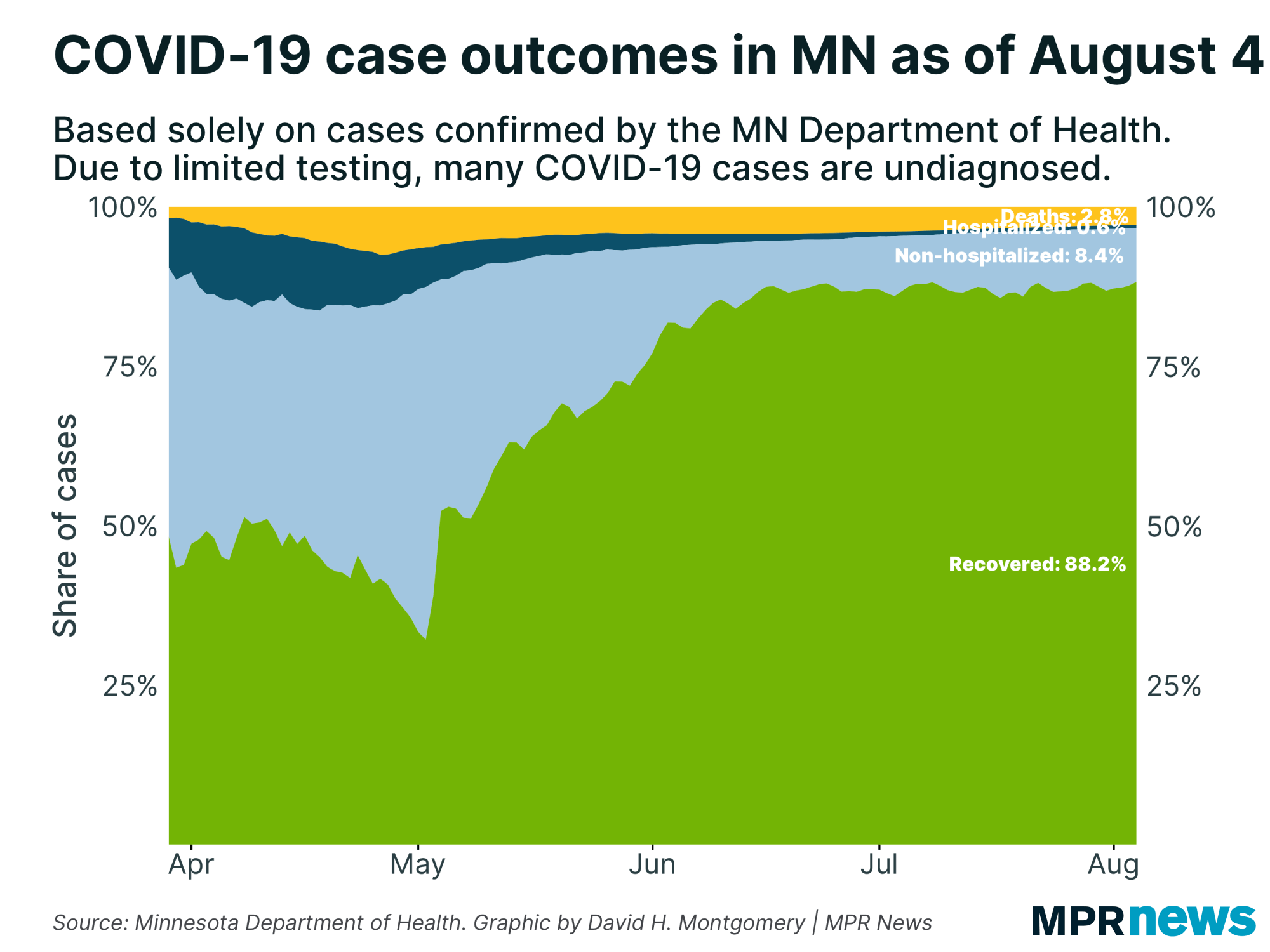April 28 update on COVID-19 in MN: 301 deaths; 'not where we need to be' on testing

Updated 6:21 p.m.
Minnesota health officials Tuesday acknowledged their “moonshot” project with Mayo Clinic and the University of Minnesota to quickly and massively ramp up COVID-19 tests may not reach Gov. Tim Walz’s goal to start testing 5,000 Minnesotans daily by next week.
"It is a moonshot. We don't get to the moon overnight,” Dan Huff, an assistant commissioner in the Minnesota Department of Health, told reporters during an afternoon briefing. "We're doing everything we can to increase capacity as soon as possible."
Walz’s current stay-at-home order is set to expire Monday. He has said the testing ramp-up is a crucial part of the effort to restart sectors of the economy safely and move more of Minnesota back to normalcy. But with the state averaging only about 2,500 daily tests completed the past few days, Huff couldn’t say if the state would be able to double that by Monday.
"We're not where we need to be on testing,” said Huff. “We know this is a ramp-up. This is not something you flip a light switch and it comes on."
Create a More Connected Minnesota
MPR News is your trusted resource for the news you need. With your support, MPR News brings accessible, courageous journalism and authentic conversation to everyone - free of paywalls and barriers. Your gift makes a difference.
His comments came hours after the Health Department reported 15 more deaths tied to the disease, putting the total at 301 since the pandemic began.

The number of people currently hospitalized jumped to 314, although those needing intensive care dipped slightly to 120. The state’s recorded 4,181 total positive tests for the disease with about 46 percent recovered to the point they no longer need to be isolated.
Officials continued to caution the public to expect more big increases in COVID-19 case counts as testing increases.
More testing, more cases
Minnesota health officials continue to say that limited coronavirus testing means that confirmed cases are only a small piece of the disease’s true spread and that a massive ramp-up in daily testing is needed to help manage the spread while reopening sectors of the economy.
Health Commissioner Jan Malcolm said Monday that the laboratories and health care providers were still dealing with “logistical issues” tied to the U-Mayo testing effort but that officials were still shooting to complete 5,000 daily tests by next week.
The department, she added, was also working to add investigators, known as contact tracers, who track down those who’ve come into contact with someone discovered to have COVID-19. With state government currently in a hiring freeze, people within the Health Department and local public health units are being trained.

Most of the deaths involve people with underlying health conditions living in long-term care facilities. That’s led to calls that everyone in those operations should be tested. Malcolm said while that was a laudable goal, the state simply wasn’t in a position to do that at this point.
"We're still in the position of needing to set some priorities for testing,” Malcolm said Tuesday. ”In complete candor it would not be something we would be able to do immediately."
Officials also cautioned the public to temper expectations of antibody testing that might show an immunity developed in some people to COVID-19.
The research hasn't been completed yet on the level of COVID-19 immunity in patients who’ve recovered or how long that immunity lasts, said Dr. Ruth Lynfield, the state epidemiologist.
Even for those people who’ve developed antibodies, she said, "we cannot say you are not going to get infected again because we do not know that.”
SW Minnesota outbreaks and the meat supply
Nobles County in southwestern Minnesota continues to be the state’s largest COVID-19 cluster outside the Twin Cities. The outbreak there is focused around the JBS pork processing plant in Worthington, which has since closed.
Reported cases in the county leaped again on Tuesday to 477.
That jump in COVID-19 discoveries is being driven by the jump in testing in the region and the Health Department’s focus in identifying cases there.
The county has the largest number of cases by far in Minnesota relative to its population.

The jump in cases came a day after Minnesota Agriculture Commissioner Thom Petersen made clear the economic woes the state’s hog producers face since COVID-19 concerns shut down JBS as well as the giant Smithfield Foods pork processing plant in Sioux Falls, S.D.
With those plants down, farmers have nowhere to sell the animals and are starting to destroy them.
Petersen said officials were looking to see if smaller slaughtering operations would collectively be able to handle 100,00 to 200,000 hogs a week. The reality, though, is that thousands of hogs will have to be destroyed before they get to market.
"The decision to euthanize animals is very emotional,” he said. While the food supply is stable, the hog farmers face a “very precarious situation,” he said.
On Tuesday, President Trump signaled he’ll order meat processing plants in the nation to stay open during the pandemic.
The parameters of that order — and whether that meant JBS and Smithfield would have to reopen immediately — weren’t immediately clear.
Asked about the order, Malcolm said she didn’t know the details but that the idea seemed “problematic to say the least” given how the spread of the disease in Nobles County is tied at least partly to the JBS plant.

More big decisions this week
Walz will announce this week whether he’ll continue or end his stay-at-home order that runs through the first weekend in May.
The same goes for restrictions on bars, restaurants that have been closed to all but takeout and delivery since the middle of March.
Both sets of curbs are due to end next Monday, barring extensions. Right now, travel that isn’t considered essential is still discouraged and workplaces that aren’t explicitly exempt should stay closed. And for now people can’t get a drink or a bite to eat in a restaurant, only to-go.
Even as factory and some office workers return to their job sites this week, Walz has made it clear that places that depend on public crowds, including bars, eateries and big sporting events, will be the last ones to return to normal business operations.
Asked whether Walz’s decision-making on the stay-at-home order hinged completely on reaching 5,000 tests per day, Malcolm indicated it wasn’t that simple.
“You know, I can’t say if we’re at 4,500 [tests] he would say ‘no’ and 6,000 he would say ‘yes,’” she said. “I think it’s going to be much more complex than that.”
Developments from around the state
Community care site planned in Twin Cities, officials say
Minnesota’s coronavirus response team is preparing to sign off on a lease for a community care site in Roseville, according to a state disclosure.
Gov. Tim Walz’s administration received legislative clearance to spent $1.84 million for preparation of an alternative care site. The notice was posted publicly on Tuesday. Requests for additional information produced a limited response from the agencies involved.
“We expect to announce a lease agreement for an alternative care site in the Twin Cities soon,” said Amber Schindeldecker, a spokesperson for the Department of Public Safety.
The division of Homeland Security and Emergency Management has been working to set up temporary facilities to help deal with COVID-19 care if hospitals become overwhelmed as cases tick up.
No contracts have been announced, and additional sites aren’t expected.
“Other sites across Minnesota have been considered, but at this point, the State Emergency Operations Center does not believe they will be necessary, and as such, we are not moving forward on the sites at this time,” Schindeldecker said.
— Brian Bakst | MPR News
Clay Co. commissioners OK hiring local contact tracers
Clay County commissioners on Tuesday approved hiring workers to do contact tracing for COVID-19 cases in the county.
Commissioners gave the public health director authority to hire contact tracers if the state gives approval for counties to trace connections to positive cases locally.
Commissioner Kevin Campbell said faster contact tracing is needed to slow the spread of COVID-19 because it helps locate people who have been exposed to the coronavirus.
"Would you like to know within hours that you were around somebody that had it, or would you like to find out five days late? And then you've been around how many more people?" said Campbell. "I think we need boots on the ground on the contact tracing here in Clay County, not in St. Paul or Minneapolis — because I think this is something that getting on it in hours could have a great impact on how far this spreads.”
County Public Health Director Kathy McKay told commissioners she expects the state to ask counties for help with contact tracing as soon as this week.
— Dan Gunderson | MPR News
In Rochester, Pence lauds Mayo Clinic testing effort
Vice President Mike Pence said Mayo Clinic's testing strategy is helping ramp up COVID-19 testing nationally.
Pence toured Mayo's labs in Rochester, Minn., Tuesday and visited with recovering patients who are donating plasma as a possible treatment for the virus.
Mayo and the University of Minnesota have been tapped by the state to ramp up testing infrastructure over the course of the next few weeks. Pence also heard updates on Mayo's role in developing coronavirus therapeutics during his visit.
— Catharine Richert | MPR News
MN Senate readies vote delaying business tax payments
The Minnesota Senate is primed to vote soon on a bill to ease some tax deadlines for businesses during the coronavirus pandemic.
The Senate Taxes Committee endorsed a plan Tuesday that gives commercial property owners until July to pay their state-assessed taxes without penalty; the local portion would still be due on May 15 unless the county they are in has relaxed the deadline. The bill also provides more flexibility with corporate and other business income taxes.
Senate Taxes Committee Chair Roger Chamberlain, R-Lino Lakes, said every bit helps. “I believe this is urgent, timely, necessary,” Chamberlain said. “And we have to be as aggressive as we can to help out employers and employees to get people back to work, and get the economy running again, as aggressively as we can.”
The combined steps would push more than $1.2 billion in tax payments from one fiscal year to the next, so the state would have to do a bit of cash-flow juggling. Minnesota already gave individual income tax filers who are on a yearly filing schedule until July 15 to make any payments on 2019 income.
Homeowners are still required to pay their property taxes by May 15, although some counties are pushing off deadlines, too. There is no state portion of homeowner property taxes, so the revenue goes for school, city and county services.
The Democratic-led House hasn’t indicated whether it will agree to shift the business tax deadlines. Revenue Commissioner Cynthia Bauerly said the Senate bill was under review by Gov. Tim Walz’s administration. She didn’t take an immediate position on it.
— Brian Bakst | MPR News
Top headlines
Pence forgoes mask on Mayo Clinic visit to learn about testing 'moonshot': The vice president was at the clinic to learn about a new coronavirus testing “moonshot” that has the famed clinic partnering with the state and its flagship university to quickly boost the state's capacity to 20,000 tests a day.
Nonessential Minnesota businesses gradually reopen: Some Minnesota companies which had closed under Gov. Tim Walz’s stay-at-home order are back in business. Monday was the first day thousands of businesses were able to reopen, as long as they follow a set of safety measures.
As pandemic continues, MN nonprofits chart new course for the long term: The coronavirus pandemic has caused a cascade of canceled concerts, fundraisers and other events that support nonprofit groups across Minnesota. As stay-at-home orders continue, rural nonprofits are trying to plan and adapt to this changed world.
COVID-19 in Minnesota
Health officials for weeks have been increasingly raising the alarm over the spread of the novel coronavirus in the United States. The disease is transmitted through respiratory droplets, coughs and sneezes, similar to the way the flu can spread.
Government and medical leaders are urging people to wash their hands frequently and well, refrain from touching their faces, cover their coughs, disinfect surfaces and avoid large crowds, all in an effort to curb the virus’ rapid spread.
The state of Minnesota has temporarily closed schools, while administrators work to determine next steps, and is requiring a temporary closure of all in-person dining at restaurants, bars and coffee shops, as well as theaters, gyms, yoga studios and other spaces in which people congregate in close proximity.